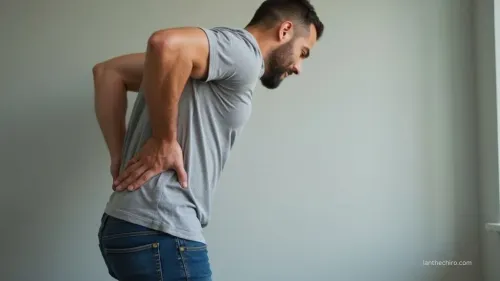Bouldering Injuries in Malaysia: Chiropractic Solutions for Climbers' Elbow & Spinal Compression
If you’re bouldering in Malaysia, your elbows and spine take a beating from gripping and hard landings, putting you at risk of climber’s elbow and spinal compression.
See a chiropractor if pain, swelling, or stiffness lasts beyond 48 hours, early treatment speeds recovery. Chiropractic adjustments restore joint function and reduce inflammation, while targeted exercises prevent future injuries.
Focus on proper warm-ups and strength work for lasting joint health. There’s more you can do to stay strong and climb pain-free.
Understanding Bouldering Injuries in Malaysian Climbers

Ever wonder why bouldering injuries seem so common among Malaysian climbers? If you’re hitting the wall regularly, you’re at risk for elbow injuries like climber’s elbow, often from repetitive gripping and flexion.
Spinal injuries can creep up, especially with hard landings or improper falls, leading to painful compression and nerve issues.
To prevent these setbacks, always commit to a solid warm-up and focus on your technique. Don’t ignore minor aches, early care is key.
Regularly stretch your forearms and back, and strengthen supporting muscles to minimise strain.
If pain persists, consult a healthcare professional familiar with climbing injuries.
Prevention, smart rehabilitation, and proper recovery strategies help you stay strong and return to the wall with confidence and resilience.
Why Climbers Are Prone to Elbow Strain and Spinal Compression
While bouldering challenges your strength and technique, it also puts significant stress on your elbows and spine. Each time you grip holds or lock off, you’re loading your flexor tendons repetitively, which can quickly lead to elbow strain if you don’t manage your training volume and recovery.
Sustained overhead and twisting moves compress the thoracic and cervical spine, making spinal compression a real risk, especially if your shoulder and core muscles are imbalanced or underprepared. Skipping proper warm-ups or pushing through fatigue increases your chances of microtrauma to your elbows and spinal discs.
High-impact falls further strain these areas. To minimise injury, focus on progressive conditioning, consistent technique, and adequate rest, these habits will help protect your elbows and spine as you climb.
When to Seek Chiropractic Care After a Climbing Injury

Recognising early warning signs after a climbing session can make all the difference in your recovery. If you’re dealing with persistent elbow pain, numbness, or tingling after bouldering, don’t wait for symptoms to fade on their own. Schedule chiropractic care promptly, especially if pain or swelling lasts beyond 48 hours, or if you notice limited range of motion or joint instability after a fall.
Addressing these issues early helps prevent long-term problems and supports a faster return to climbing. Watch for signs of spinal compression too, such as ongoing back pain, radiating nerve pain, or weakness, these need professional evaluation.
Don’t ignore recurrent discomfort or stiffness; early intervention with chiropractic care aids in injury prevention and ensures your rehabilitation stays on track.
Chiropractic Techniques for Elbow and Spine Recovery
If you’re recovering from a bouldering injury, targeted chiropractic techniques can make a significant difference in your rehabilitation. For climbers’ elbow, chiropractic care uses soft tissue manipulation and precise joint adjustments to reduce tendon strain, decrease inflammation, and restore joint mobility. These methods promote healing and restore function, so you can return to the wall with confidence.
For spinal compression injuries, chiropractors often employ gentle spinal mobilisation and high-velocity low-amplitude (HVLA) adjustments. These techniques help alleviate nerve compression, relieve pain, and realign affected vertebrae from bouldering falls.
Preventive Strategies for Long-Term Climbing Health

Beyond effective rehabilitation, building a foundation for long-term climbing health starts with proactive prevention. Commit to a thorough warm-up routine of at least 10-15 minutes before every session, this simple step is essential for injury prevention, especially against climbers’ elbow and spinal compression.
Focus on strengthening your forearms, shoulders, and core with targeted exercises; these bolster joint stability and reduce long-term strain. Schedule regular chiropractic check-ups to catch early signs of overuse or misalignment before they become chronic injuries.
Prioritise proper climbing techniques and avoid overtraining by varying your movements and including rest days. Don’t underestimate the importance of active recovery, strategies like stretching and gentle mobility work help sustain healthy joints and spine, ensuring you can keep climbing strong for years.
Frequently Asked Questions
How do I recover from climbers’ elbow?
Rest the affected arm, apply ice regularly, and begin gentle forearm stretches once pain allows. Start strengthening exercises gradually. For a full recovery and to avoid re-injury, consult a chiropractor for tailored rehab and load management.
Is bouldering bad for the spine?
Not inherently, but poor landing technique, lack of mobility, and skipping warm-ups can increase spinal strain. Prioritise proper form, joint prep, and recovery to reduce injury risk.
What safety technique helps prevent injury while bouldering?
The key technique is spotting. A spotter helps guide your fall and ensures the crash pad is positioned correctly. This, along with proper pad use, reduces impact-related injuries.
How can I recover faster after bouldering?
Speed up recovery by resting, icing sore areas, doing mobility work, hydrating, eating enough protein, and getting good sleep. Chiropractic care can also help address joint restrictions early before they compound.
Conclusion
Picture yourself reaching for the next hold, pain-free, confident, and strong.
By listening to your body and seeking chiropractic care when needed, you’ll keep your elbows and spine healthy for the climbs ahead. Don’t wait for aches to sideline your passion; take proactive steps with targeted adjustments and smart rehab exercises.
With the right support, you’ll stay on the wall longer, recover faster, and enjoy every moment Malaysia’s vibrant bouldering scene has to offer.














